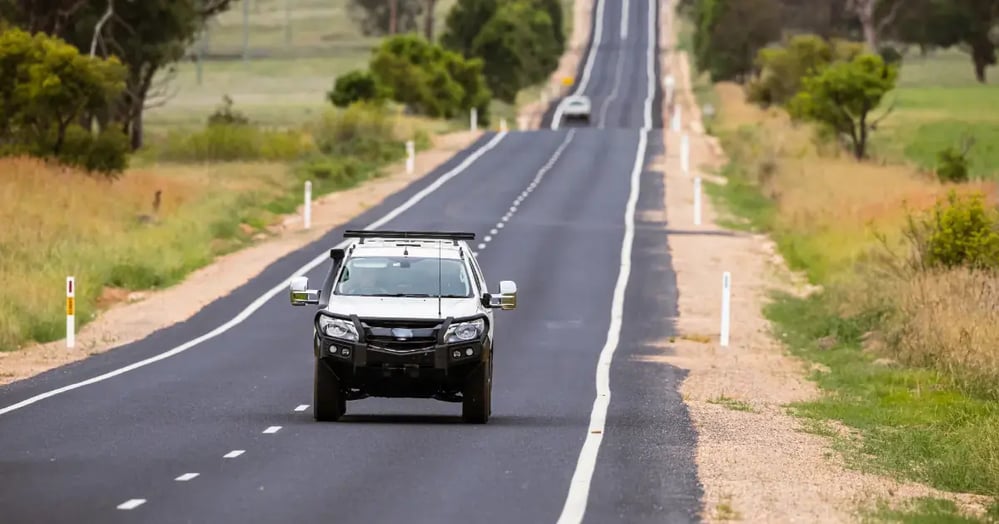The Best Utes for Fuel Economy
by Team Tradify, October 15, 2024

Table of Contents
Diesel utes typically offer the best fuel economy thanks to their ability to extract more energy per litre. They also produce higher torque at lower RPMs, which is useful for towing and getting your gear up those steep hills. To further boost your fuel economy, consider your vehicle's weight, aerodynamics, and features like start-stop systems or adaptive cruise control. And try to be honest with yourself — if you don't truly need a 4WD, opt for a 2WD to save more.
Looking to make your business more efficient? Try Tradify free for 14 days.
Low on time? Skip ahead!
- Toyota Hilux 2.8L Turbo-Diesel
- Ford Ranger 2.0L Bi-Turbo Diesel
- Mazda BT-50 3.0L Turbo-Diesel
- Isuzu D-Max 3.0L Turbo-Diesel
- Mitsubishi Triton 2.4L Turbo-Diesel
1. Toyota Hilux 2.8L Turbo-Diesel
Fuel consumption: 7.5L/100km

The Toyota HiLux 2.8L Turbo-Diesel with the 2024 mild-hybrid V-Active Technology, featuring a 48-volt battery and electric motor generator, improves fuel economy by about 10% over the non-hybrid version. For models such as the SR5 and Rogue variants, the combined fuel consumption is claimed to be as low as 7.2L/100km. This setup also includes improved stop/start functionality and reduced noise and vibration.
However, real-world conditions might result in a slightly higher fuel consumption. For instance, in heavy urban traffic, fuel consumption may end up closer to 9.1L/100km. This will depend on driving conditions and load addition. However, the Hilux's power output remains strong, with 150kW of power and 500Nm of torque, making it a solid fuel-efficient choice, as well as highly capable for towing and off-road activities.
2. Ford Ranger 2.0L Bi-Turbo Diesel
Fuel consumption: 7.4L/100km

The Ford Ranger offers a smaller, bi-turbo diesel engine that maximises fuel efficiency while still delivering strong torque for towing and off-road performance. These variants include the XL 4x4 single and super cab chassis Hi-Rider, XL 4x4 super cab tray back Hi-Rider, XLT 4x4 super cab tray back, Sport and Wildtrak.
The Ford Ranger 2.0L Bi-Turbo Diesel, especially its 2024 models, has a combined fuel consumption of 7.4L/100km. The engine generates 154kW of power and 500Nm of torque, offering strong towing capability (up to 3,500kg braked). This bi-turbo diesel is mated to a 10-speed automatic transmission, ensuring smooth gear shifts and optimised power delivery across varying terrains.
Real-world fuel economy, however, may vary based on driving conditions, with some tests indicating figures closer to 9.6L/100km in urban driving scenarios. Still, for highway cruising, the Ford Ranger performs better, with fuel consumption staying around the claimed average. The Ford Ranger’s lineup includes several variants such as the XL, XLT, Sport, and Wildtrak, all of which use this same bi-turbo diesel engine.
3. Mazda BT-50 3.0L Turbo-Diesel
Fuel consumption: 7.7L/100km

The Mazda BT-50 XS, including the 2024 model, is equipped with a 1.9-litre turbo-diesel engine, which produces 110kW of power and 350Nm of torque. Its fuel consumption is rated at 7.7L/100km in combined city and highway driving conditions. This engine is paired with a 6-speed automatic transmission and provides a solid balance between fuel efficiency and performance. For those requiring more power, the BT-50 also offers a 3.0-litre turbo-diesel option, delivering higher performance but slightly increased fuel consumption (up to 8.0L/100km). With a 76-litre fuel tank, the BT-50 XS provides a decent driving range, which is estimated to be around 987 kilometres on a full tank. Additionally, the Mazda BT-50 is known for its strong safety features, including a 5-star ANCAP safety rating, and advanced driver assistance systems, such as autonomous emergency braking and lane-departure warning.
4. Isuzu D-Max 3.0L Turbo-Diesel
Fuel consumption: 7.8L/100km
.webp?width=500&height=323&name=DMAX%20(1).webp)
A long-time favourite for heavy-duty tasks, the D-Max’s diesel engine is both fuel-efficient and powerful. The 2024 Isuzu D-Max, particularly with its 3.0-litre turbo-diesel engine, strikes a solid balance between power and fuel efficiency, making it a favourite for those who need a dependable ute for heavy-duty tasks. The engine produces 140kW of power and 450Nm of torque, allowing for strong towing capabilities—up to 3,500kg—while maintaining respectable fuel economy. The combined fuel consumption for the 3.0-litre D-Max is rated at 7.8L/100km, which is impressive given its performance and off-road capability. For those looking for even more efficiency, the smaller 1.9-litre engine variant offers an average fuel consumption range between 6.7L and 7.0L/100km, depending on the configuration.
5. Mitsubishi Triton 2.4L Turbo-Diesel
Fuel consumption: 7.8L/100km

The Mitsubishi Triton 2024 is powered by a 2.4-litre bi-turbo diesel engine that delivers 150kW of power and 470Nm of torque from an 80-litre fuel tank. This engine is mated to a 6-speed automatic transmission and is available with both rear-wheel drive (RWD) and four-wheel drive (4WD) configurations. One of its standout features is its fuel efficiency, as the combined fuel consumption for the Triton is 7.8L/100km. The new bi-turbo setup features a small turbo for low-end torque and a larger turbo for high-end performance, with an impressive 3,500kg towing capacity. The Triton also incorporates features like automatic engine idle-stop and underbody aerodynamic enhancements, which contribute to its improved fuel economy over previous models.
Ready to organise your business?
Sign up for a 14-day free trial. No credit card required. No commitment. Or pop over to one of our live demo webinars to see Tradify in action.
Related articles

Quick Quotes Mean More Jobs for Sharp Air Conditioning

How To Set Up a Google Business Profile (for Trade Businesses)

Aussie Electrician Reduces Admin Time by 95%
Give Tradify a go for free!
Save 10+ hours/week on business admin with the highest-rated job management software for tradespeople.
With free one-on-one training and phone support, it's never been easier to get started.




